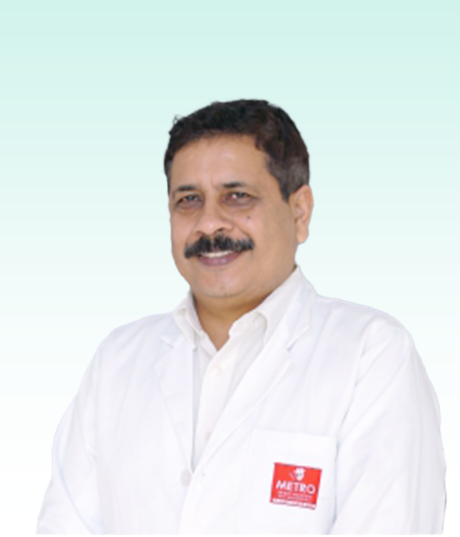Lumbar Puncture (LP)
Lumbar puncture (LP) or spinal tap may be done to diagnose or treat a condition. For this procedure, your healthcare provider inserts a hollow needle into the space surrounding the spinal column (subarachnoid space) in the lower back to withdraw some cerebrospinal fluid (CSF) or inject medicine.

CSF is a clear fluid that bathes and cushions the brain and spinal cord. It is continuously made and reabsorbed in the brain. CSF is made up of cells, water, proteins, sugars, and other substances that are essential to maintain balance in the nervous system.
Who Needs Lumbar Puncture (LP)
Lumbar puncture may be recommended for individuals who exhibit symptoms or conditions that suggest an abnormality in the central nervous system (CNS). It is commonly used in the diagnosis and management of conditions such as meningitis, encephalitis, multiple sclerosis, intracranial hemorrhage, and certain types of cancer affecting the CNS. Additionally, it can be performed to administer medications, such as chemotherapy drugs or antibiotics, directly into the spinal canal.
When to See a Specialist
It is important to consult a specialist, such as a neurologist or an interventional radiologist, if you are experiencing symptoms such as severe headaches, neurological deficits, altered mental status, or suspected CNS infections. The specialist will evaluate your medical history, conduct a physical examination, and recommend lumbar puncture if deemed necessary for diagnostic or therapeutic purposes.
Procedure
- Preparing for the Procedure: The patient is positioned on their side or sitting up, and the lower back area is cleaned and sterilized.
- Numbing the Area: A local anesthetic is injected into the skin and deeper tissues to numb the area.
- Inserting the Needle: A thin, hollow needle is carefully inserted between the lower vertebrae into the subarachnoid space, which is the space surrounding the spinal cord.
- Collecting CSF: Once the needle is correctly positioned, the specialist collects a small amount of CSF using a syringe. The pressure and flow rate of the CSF may be measured during the procedure.
- Removing the Needle: After the CSF is collected, the needle is gently removed, and a small bandage is placed over the puncture site.
- Post-Procedure Care: The patient may be required to lie flat for a period of time to prevent headaches and reduce the risk of complications.
Road to Recovery
Recovery from a lumbar puncture is usually quick and uncomplicated. The patient may experience mild soreness or discomfort at the puncture site, which can be relieved with over-the-counter pain medications. It is important to follow the healthcare provider’s instructions regarding rest, activity restrictions, and fluid intake after the procedure.
Risk Management
Lumbar puncture is generally considered a safe procedure, but like any medical intervention, it carries certain risks. Potential risks include headache, infection, bleeding, nerve damage, and rare complications such as brain herniation. To minimize these risks, it is crucial to have the procedure performed by an experienced specialist and to follow proper sterile techniques.
Benefits of Lumbar Puncture (LP)
Lumbar puncture is a valuable diagnostic and therapeutic tool in the field of neurology. It allows healthcare professionals to obtain important information about the CNS, including the presence of infection, inflammation, tumors, or other abnormalities. It can aid in the accurate diagnosis and management of various neurological conditions, leading to appropriate treatment and improved patient outcomes.
Frequently Asked Questions
Does lumbar puncture hurt?
The procedure involves a needle insertion, so some patients may feel mild discomfort or pressure. However, a local anesthetic is administered to numb the area, which helps minimize pain during the procedure.
How long does a lumbar puncture take?
The actual procedure usually takes around 30 minutes. However, the preparation and post-procedure monitoring may extend the total time spent in the healthcare facility.
Are there any specific instructions to follow after a lumbar puncture?
It is common to be advised to rest and avoid strenuous activities for a day or two after the procedure. It is also recommended to drink plenty of fluids to prevent dehydration and to report any unusual symptoms, such as severe headaches or infection signs, to the healthcare provider.
Can lumbar puncture provide definitive diagnoses?
Lumbar puncture is a diagnostic tool that provides valuable information, but it may not always provide a definitive diagnosis. Additional tests and evaluations may be required to reach a conclusive diagnosis.
Treatment Plans
- Trauma & intensive care $59
- Aged Care $29
- Community Services $25
- Diagnosis & Investigation $48
- Medical & Surgical $82
- Mental Health $74
- Rehabitation $24
- Specialised Support Service $19
- Trauma & intensive care $59
- Aged Care $29
- Community Services $25
- Diagnosis & Investigation $48
- Medical & Surgical $82
- Mental Health $74
- Rehabitation $24
- Specialised Support Service $19
Treatians As The Best Choice
Treatians understand that seeking medical treatment abroad can be a daunting experience for patients and their families. That’s why the company offers end-to-end support to its clients, from the initial consultation to post-treatment care. The company provides personalized treatment plans that are tailored to meet the individual needs of each patient, and its team of dedicated professionals is always on hand to provide guidance and support throughout the entire process. Contact us at +91- 7982312582, drop your email [email protected]
- Trauma & intensive care
- Aged Care
- Community Services
- Diagnosis & Investigation
- Medical & Surgical
- Mental Health
- Rehabitation
- Specialised Support Service
Service Recipient Says


















I was struggling to find the right treatment for my chronic migraines until I used Treatians. The platform connected me with a fantastic neurologist who provided a treatment plan that has significantly reduced my migraines. I couldn't be happier with the service.
Nitaya Chai Thailand